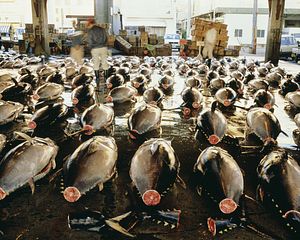Distant but powerful fishing nations and small island states in the South Pacific Ocean came together in Samoa this week in what appears to have been a failed attempt to agree on conservation measures for the world’s most vulnerable and valuable tuna fisheries.
With roughly 60 per cent of global tuna catches, the western and central Pacific Ocean is home to a variety of tuna species that supply markets around the world. Estimates have put the value of the fishery as high as $7.2 billion in recent years, with total catches hovering at 2.5 million metric tons in 2012. Currently, commercial fishing operations in the region are dominated by larger, distant water fishing nations, including China, Japan, Taiwan, the United States, and members of the European Union.
Delegates from Pacific Island nations had planned to form a united force at the Samoa meeting, calling on the body that manages the fishery to urgently adopt a number of conservation measures at its annual meeting. Greenpeace is reporting than none of the measures were adopted. Journalists were not permitted to attend the final session of the meeting.
The Western and Central Pacific Fisheries Commission (WCPFC) came into force in 2005 with the aim of bringing together the large fishing nations and small island states, while overseeing issues surrounding management of the highly migratory tuna stocks of the Pacific. Dr. Transform Aqorau – who heads a sub regional group comprising eight small Pacific island nations that effectively control 50 percent of the world’s canning tuna supply through their lucrative fishing grounds – says the issue of overfishing in the region must be addressed.
Bigeye tuna is a particular species of tuna prized in sushi markets around the globe, and was specifically identified by Dr. Aqorau as being under threat. Recent estimates indicate that bigeye is heading towards the same fate of Pacific bluefin, with stocks currently assessed at 16 percent of their historic population. Estimated at a mere 4 percent of its historic stock size, Pacific bluefin was also on the agenda at this week’s meeting.
Dr. Aqorau had planned to pursue a number of conservation measures, calling on the larger fishing nations for support. “We are the only ones that have taken an interest to protect our resource,” he said to reporters last week. “If we don’t get a measure, at least we have taken the moral high ground.” Apparently, after five days of talks, he will have to settle for the moral high ground.
In Samoa for the meeting, Pacific tuna Programme Manager Bubba Cook from the World Wildlife Fund described tuna conservation as “… The single most important issue for the South Pacific region.”
“When you look at the revenue generated from the tuna fisheries, which is about $7 billion annually, which could also be a sustainable and renewable resource that could last in perpetuity, it’s an incredibly important economic engine for the region,” he said.
Pacific island states and NGO’s also used the talks in a bid to highlight what has been described as poor catch reporting by a number of nations, including China, Japan, Chinese Taipei, and Korea.
“This intentional disregard of international law and regulations through refusal to provide operational level data from these countries must end and, therefore, must be addressed by the Commission at its upcoming WCPFC meeting as an urgent priority,” read a WWF statement.
Members of the WCPFC include the United States, Japan, Australia, New Zealand, France, Australia, Canada, and China, as well as small island states such as Papua New Guinea, Fiji, Federated States of Micronesia, Tonga, Kiribati, and the Cook Islands.
Emmanuel Samoglou is a freelance reporter who has covered the Pacific region for the past two years, including 18 months with the Cook Islands News, where he worked as a political reporter.

































